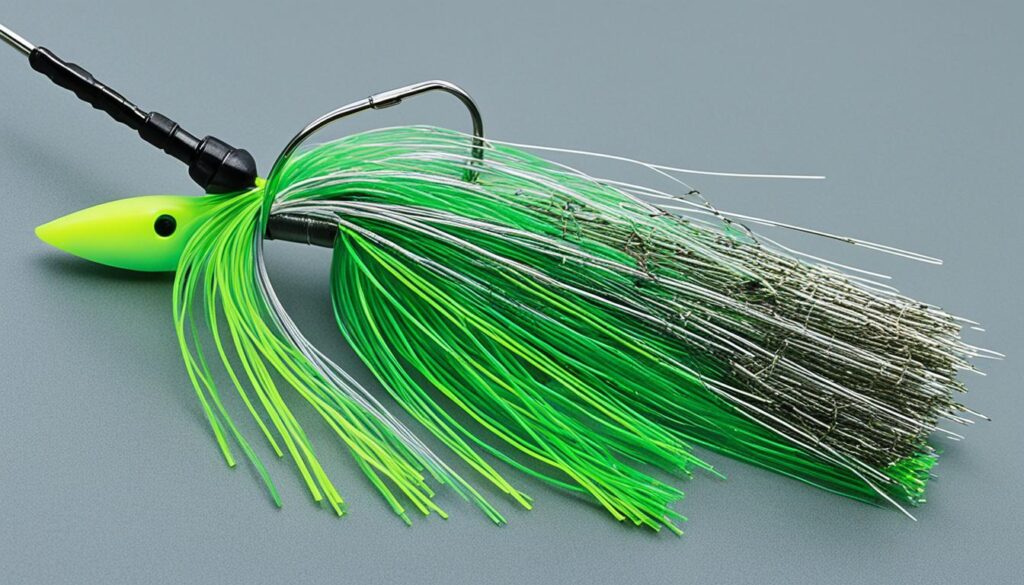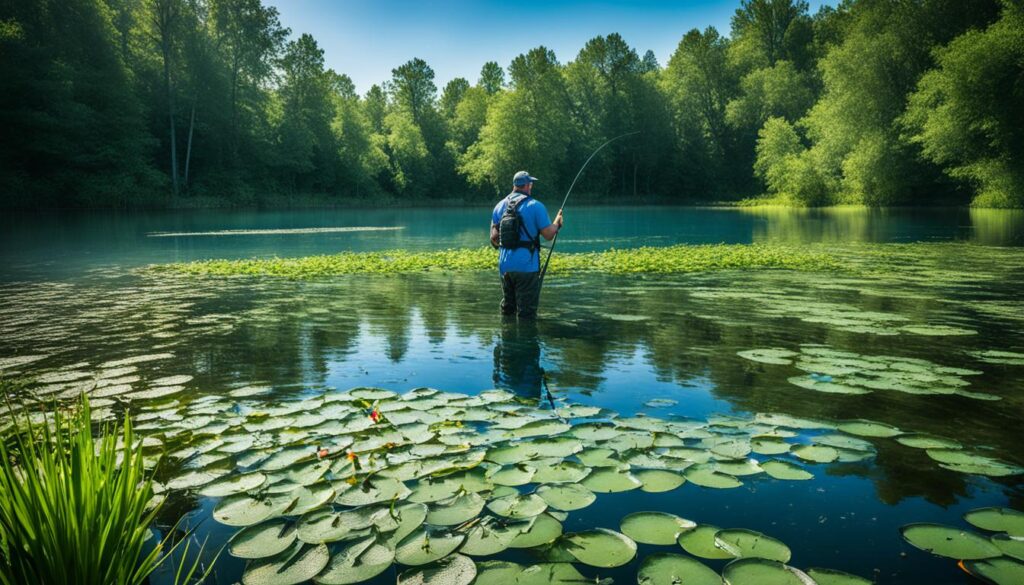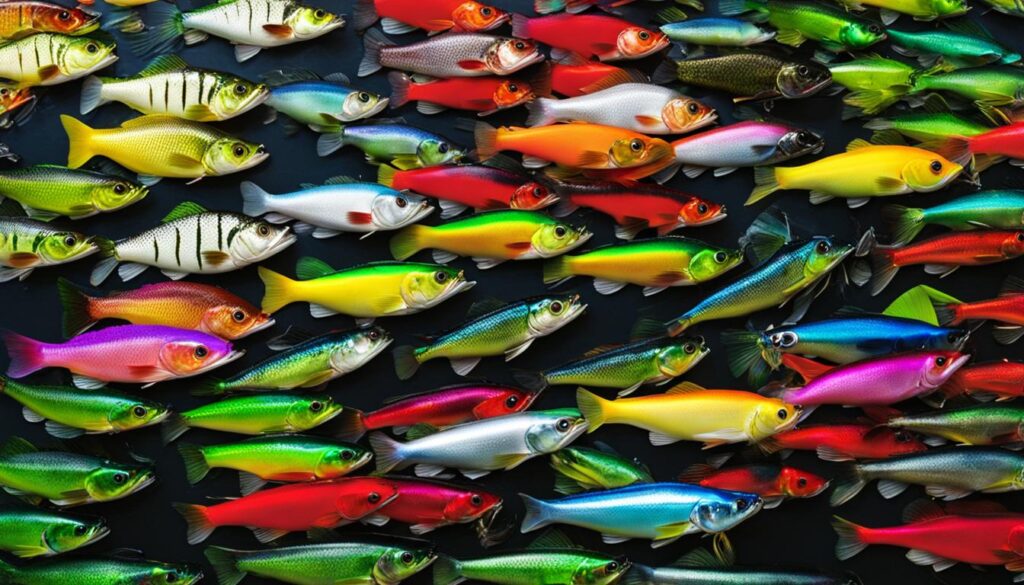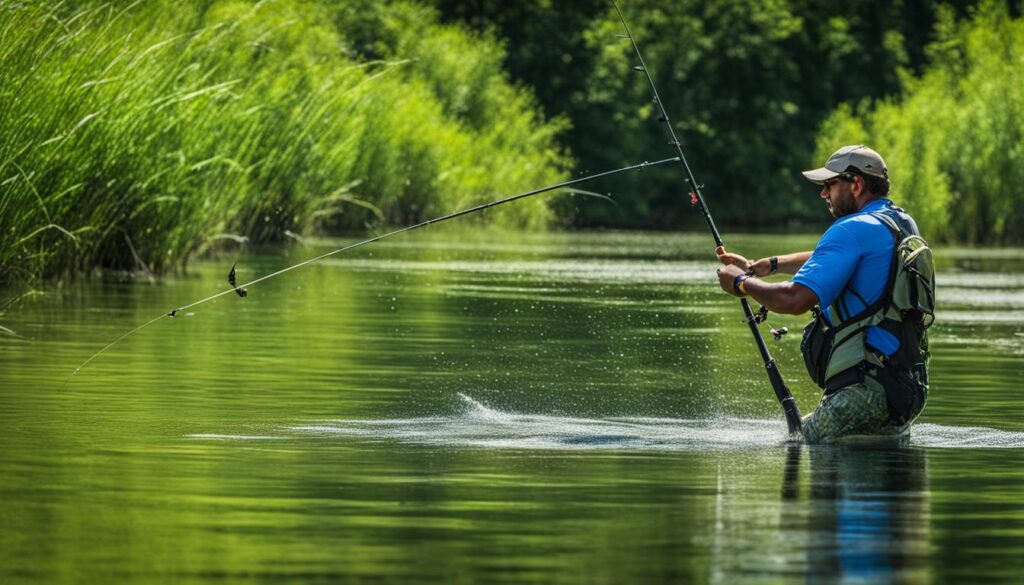In the world of bass fishing, there are lures that stand out from the rest. Swim jigs are one such lure, especially when it comes to targeting bass in shallow water during the summer months. With their unique design and effective fishing techniques, swim jigs have become a favorite among anglers looking for success in the shallows.
When it comes to summer fishing techniques, shallow water fishing is a key strategy. Bass often gravitate towards shallow areas in search of cover, shade, and easy prey. This is where swim jigs excel. With their ability to navigate through various types of cover, such as wood, docks, lily pads, and aquatic vegetation, swim jigs can entice bites from bass lurking in the shallows.
The anatomy of a swim jig is designed with success in mind. Its tapered head and forward line tie allows for horizontal retrieves, enticing bass with lifelike movement. Adding a plastic trailer to the jig further enhances its action and profile, making it irresistible to bass.
Successful swim jig fishing requires the right techniques. Anglers often employ an erratic retrieve, ripping the jig free from vegetation or aggressively deflecting it off branches. Varying the retrieve speed based on water clarity mimics the natural movement of prey, increasing the chances of a reaction strike. Patience and persistence are key when fishing swim jigs, as exploring different areas and cover attributes can unlock the secret to enticing bites.
Having the right tackle is essential for maximizing success with swim jigs. A medium-heavy rod, fast reel, and appropriate line, such as a 30-pound braid or fluorocarbon, provide the necessary strength and control to effectively swim the jig. Matching the color choice to the water clarity is crucial, with white being a solid starting point.
Swim jigs not only offer an exciting and productive approach to bass fishing, but they also provide an opportunity to enjoy the great outdoors during the summer months. So gear up, head to your favorite fishing spot, and give swim jigs a try. You might just reel in the bass of your dreams!
Angler’s Essentials
- Swim jigs are effective lures for targeting bass in shallow water during the summer months.
- Shallow water fishing is a key strategy in summer bass fishing, providing cover and a food source for bass.
- The anatomy of a swim jig, including its tapered head and forward line tie, make it well-suited for horizontal retrieves.
- Successful swim jig fishing techniques include an erratic retrieve and varying the retrieve speed based on water clarity.
- The right tackle, including a medium-heavy rod, fast reel, and appropriate line, is crucial for swim jig fishing.
The Importance of Shallow Water Fishing in Summer
In summer bass fishing, targeting shallow water can be a game-changer. While many bass migrate offshore after spawning, a smaller population prefers to stay in shallow areas, especially if they have adequate cover. Shallow water provides several advantages for bass, making it an essential tactic for anglers looking to maximize their success.
Shade and Ambush Points
One of the main reasons bass love shallow water is the abundance of shade it offers. As the temperature rises, bass seek refuge in the cooler, shaded areas provided by overhanging trees, docks, and vegetation. These shaded spots not only provide relief from the heat but also serve as prime ambush points. Bass can lie in wait, hidden from prey, ready to strike when an opportunity presents itself.
Plentiful Food Source
Shallow water in the summer is teeming with bluegill, a favorite food source for bass. Bluegill tend to congregate in these areas, providing bass with a readily available and abundant food supply. By targeting shallow water, anglers can capitalize on this natural feeding behavior and increase their chances of hooking a big bass.
Key Areas for Shallow Bass
To effectively fish for shallow bass in the summer, it’s essential to focus on specific areas that they frequent. Gradually tapering flats and points with scattered bushes in 2 to 4 feet of water are prime locations to find shallow bass. Additionally, isolated wood cover in the back ends of shallow pockets can be productive hunting grounds. These spots offer bass the ideal combination of cover, shade, and access to a plentiful food source.
Optimal Water Clarity for Swim Jig Fishing
When targeting shallow bass, water clarity plays a crucial role in determining lure selection. In general, water clarity of around 12 to 18 inches is considered optimal for swim jig fishing. This clarity allows bass to track the movement of the bait and increases the likelihood of triggering a strike. Anglers should pay attention to water clarity when choosing their fishing spots and adjust their techniques accordingly.
Incorporating swim jigs into your shallow water fishing arsenal can be highly effective. The next section will delve into the anatomy of swim jigs and how they contribute to successful fishing techniques.
The Anatomy of a Swim Jig

When it comes to bass fishing jigs, swim jigs are a popular choice among anglers. These versatile lures are specifically designed for horizontal retrieves in shallow water. Let’s take a closer look at the swim jig anatomy and understand why it’s a must-have in your tackle box.
Swim jigs feature a tapered head and a forward line tie, allowing them to track horizontally through the water. This design gives them a natural swimming motion that mimics the movement of baitfish, making them highly attractive to bass. The weedless nature of swim jigs enables them to navigate through thick cover, such as grass, without getting snagged.
For heavy cover situations, swim jigs come equipped with a heavier weed guard and a stronger hook. This ensures that the lure can penetrate through vegetation and withstand the intense battles with big bass. The weight of swim jigs typically ranges from 3/8 to 1/2-ounce, providing the right balance for a controlled retrieve and accurate casting.
To enhance the profile and increase the action of the swim jig, anglers often add plastic trailers. Twin-tail grubs and craws are popular choices that can be attached to the jig. These trailers not only add bulk and create a larger silhouette but also provide enticing movement that triggers strikes from bass.
Now that we’ve explored the swim jig anatomy, let’s dive into the techniques for fishing swim jigs and uncover the secrets to maximizing your success on the water.
A swim jig with its tapered head, forward line tie, and plastic twin-tail grub. Image source: seowriting.ai
Techniques for Fishing Swim Jigs
When it comes to bass fishing techniques, the swim jig is a versatile lure that can be highly effective in drawing strikes. While it can certainly produce results in open water, its true power lies in its ability to elicit reaction strikes from inactive bass holding tight to cover.
To successfully fish swim jigs, it’s all about imparting an erratic action to the lure that mimics the movements of natural prey. Two effective techniques include ripping the jig free from vegetation or aggressively deflecting it off branches. These sudden movements can trigger a predatory response from bass, enticing them to strike.
Remember, the key is to be unpredictable. The swim jig should mimic the panicked movements of baitfish or prey, creating a sense of vulnerability that bass find irresistible.
The speed of the retrieve is another important factor to consider. In clearer water, a faster retrieve can imitate the fleeing panic of bluegill, a preferred food source for bass. On the other hand, in murkier water, a slower retrieve can help the bass locate the lure and strike.
Adding lifelike quiver to the swim jig’s skirt can also increase its effectiveness. Periodically surging the rod tip and giving it a gentle shake can give the lure an enticing action that bass find hard to resist.
It’s worth mentioning that swim jig fishing often requires persistence and patience. Grinding it out in the shallows and making hundreds of casts is often necessary to find the key cover attributes that are holding the bass. But once you find the right technique and hone in on the bass’s behavior, the rewards can be well worth the effort.
Tips for Fishing Swim Jigs:
- Practice an erratic action by ripping the jig free from vegetation or deflecting it off branches to trigger reaction strikes.
- Vary the speed of the retrieve based on water clarity, imitating the movements of prey.
- Surge the rod tip periodically and shake it gently to add lifelike quiver to the jig’s skirt.
- Grind it out in the shallows and be persistent, as finding the right cover attributes can lead to success.
Next, let’s take a closer look at the tackle recommendations for swim jig fishing.
Tackle Recommendations for Swim Jig Fishing:
| Rod | Reel | Line |
|---|---|---|
| Medium-Heavy Rod | Fast Reel (7:1 or 8:1) | 30-pound Braid or Fluorocarbon |
The ideal setup for swim jig fishing includes a medium-heavy rod with enough strength for a solid hookset and the ability to maneuver fish out of cover. A fast reel with a speed of 7:1 or 8:1 allows for quick line retrieval, making it easier to keep up with the swift and erratic movements of the swim jig. As for the line, 30-pound braid or fluorocarbon is recommended, with braid offering power and castability and fluorocarbon providing invisibility in clear water.
Now that we’ve covered the techniques and tackle recommendations for fishing swim jigs, let’s move on to the importance of shallow water and shallow bluegill in summer bass fishing.
Tackle Recommendations for Swim Jig Fishing
When it comes to swim jig fishing, having the right tackle is essential for success. Here are my recommendations:
Rod
For swim jig fishing, I recommend using a medium-heavy rod around 7 feet in length. This will give you the perfect balance of strength and sensitivity. A longer rod allows longer casts and better control over the fish once hooked.
Reel
Choose a fast reel with a speed of 7:1 or 8:1. This will provide you with the necessary speed and power to reel in fish effectively. A fast retrieve is crucial for swim jig fishing, as it helps create the realistic action that entices bass to strike.
Line
Regarding line choice, two options work well for swim jig fishing: 30-pound braid or fluorocarbon. Braid offers excellent strength and castability, allowing you to make long, accurate casts. Fluorocarbon, on the other hand, provides invisibility in clear water, making it ideal for situations where bass are more cautious.
Jig Weight
I recommend using jigs in the 3/8 to 1/2-ounce range for swim jig fishing. This weight allows the jig to swim effectively through the water and maintain the desired depth. It also provides enough weight to ensure a solid hookset when a bass strikes.
Trailers
Add plastic trailers to your swim jig to increase its profile and provide additional action. Craws and paddle tails are excellent choices for trailers. Experiment with different colors and styles to find what works best in various conditions.
Color Choice
Color choice is an important factor in swim jig fishing. Start with white as a good all-around color choice. However, don’t be afraid to experiment with different colors based on the water clarity and the forage present in the area. The goal is to match the hatch and imitate the prey fish that bass are feeding on.
| Tackle | Recommendations |
|---|---|
| Rod | Medium-Heavy Rod, 7 feet in length |
| Reel | Fast Reel, 7:1 or 8:1 gear ratio |
| Line | 30-pound Braid or Fluorocarbon |
| Jig Weight | 3/8 to 1/2 ounce |
| Trailers | Plastic Craws and Paddle Tails |
| Color Choice | Based on Water Clarity and Forage |
The Importance of Shallow Water and Shallow Bluegill

Shallow water is crucial for successful summer bass fishing. It provides better oxygen levels and abundant cover for bass, making it an ideal habitat for them. One key factor in attracting bass to shallow areas is the presence of shallow bluegill. Bass have a natural preference for feeding on bluegill, and these small fish can be found in abundance in shallow waters with cover, such as boat docks, overhanging trees, and hydrilla clumps. The shade provided by these areas is not only attractive to bluegill but also to bass, who seek cover and food in these locations.
To effectively locate shallow bass, it is helpful to focus on fishing areas with bluegill pods. Look for areas where bluegill are congregating, as this indicates the presence of potential bass feeding grounds. Additionally, observing the presence of dragonflies can be a good indicator of shallow bass activity, as these insects often inhabit the same areas as bluegill and bass.
Understanding the importance of shallow water and shallow bluegill in summer bass fishing is essential for consistently finding and catching bass in these environments. By targeting areas with ample cover and an abundance of bluegill, anglers can increase their chances of success and enjoy a rewarding fishing experience.
Fishing Swim Jigs Around Different Types of Cover
When it comes to fishing with swim jigs, you have the opportunity to explore and target various types of cover. These versatile lures can be effectively used in different environments to attract strikes from bass. Here are some of the key types of cover where you can fish swim jigs:
- Grass: Swim jigs can be run through beds of grass, enticing bass to strike. The lure’s weedless design allows it to navigate through the vegetation without snagging.
- Stumps: The structure provided by stumps is an ideal hiding place for bass. By casting your swim jig near stumps and working it along their edges, you can trigger strikes from lurking bass.
- Laydowns: Fallen trees or branches that lie partially submerged in the water are known as laydowns. Swim jigs can be worked along the edges of laydowns, imitating the movement of prey and enticing bass to react.
- Rip Rap: Rip rap refers to rocks lining the banks of reservoirs or rivers. By casting swim jigs along these rocky areas and retrieving them in a way that mimics the movement of baitfish, you can entice bass to strike.
- Chunk Rock Banks: Chunk rock banks are characterized by large, irregular rocks along the shoreline. These areas provide bass with hiding spots and ambush points. By swimming your jig along the edges of the rocks, you can provoke strikes from bass.
| Type of Cover | Description | Tips |
|---|---|---|
| Grass | Beds of aquatic vegetation | – Retrieve the swim jig through the grass – Vary the speed to imitate fleeing prey – Focus on edges and openings in the grass |
| Stumps | Submerged tree stumps | – Cast near stumps and work the jig along their edges – Use a slow and steady retrieve – Watch for subtle strikes |
| Laydowns | Fallen trees or branches in the water | – Target the edges of the laydowns – Retrieve the jig with short hops and pauses – Pay attention to any movement or line twitch |
| Rip Rap | Rocks along the shoreline | – Cast along the rocky areas and retrieve the jig parallel to the shore – Vary the speed and use a stop-and-go retrieve – Keep an eye out for strikes as the jig bounces off the rocks |
| Chunk Rock Banks | Shoreline with large, irregular rocks | – Swim the jig along the edges of the rocks – Use a slow and steady retrieve – Experiment with different colors and trailers to match the surroundings |
Tips for Success with Swim Jigs

To be successful with swim jigs, it is important to swim them high in the water column to attract bass and keep them within sight. By positioning the swim jig at the appropriate depth, you increase the chances of triggering a strike.
One effective technique for swim jig fishing is power swimming. This involves pumping the rod to slow down the bait and keep it in the strike zone longer. The erratic action created by this technique can entice reaction strikes from bass, especially those that are not actively feeding.
Contacting the cover is another key strategy when fishing swim jigs. By bumping the jig against logs, rocks, or other cover, you imitate the movements of prey fish, triggering the bass’s predatory instincts. Remember to give the bass one step before setting the hook, allowing it to fully engulf the swim jig before attempting to land the fish.
Even without cover, swim jigs can be effective in drawing strikes. The action of the bait, combined with the realistic movement of the skirt, can entice bass to strike out of curiosity or aggression. It’s important to experiment with different retrieval speeds and actions to find what works best in different conditions.
When it comes to color choices for swim jigs, simplicity is key. Stick to colors that closely resemble the natural prey in the area. Some recommended color patterns include black and blue, bluegill, and shad. These colors have proven to be successful in imitating the most common forage species in bass habitats.
Swim Jig Tips Summary:
– Swim jigs should be swum high in the water column to attract bass.
– Power swimming can be effective in eliciting reaction strikes.
– Contacting the cover imitates the movements of prey fish.
– Give the bass one step before setting the hook to increase the chances of successful hookups.
– Swim jigs can be effective even without cover, relying on the bait’s action to induce strikes.
– Stick to simple color choices that imitate natural prey species in the area.
Tackle Recommendations for Swim Jig Fishing
When it comes to swim jig fishing, having the right tackle is crucial for success. Here are my recommendations for swim jig gear that will help you maximize your chances of landing those elusive bass.
1. Rod:
I suggest using a medium-heavy rod around 7 feet in length. This will provide you with enough strength to ensure a solid hookset and the ability to maneuver fish out of cover.
2. Reel:
A fast reel with a speed of 7:1 or 8:1 is ideal for swim jig fishing. The high retrieval rate allows you to quickly reel in any slack line and keep the pressure on the fish.
3. Line:
For swim jig fishing, I recommend using either 30-pound braid or fluorocarbon line. Both options have their advantages depending on the fishing conditions. Braid offers excellent power and castability, while fluorocarbon provides invisibility in clear water.
4. Swim Jig:
Choose swim jigs in the weight range of 3/8 to 1/2-ounce. These weights are versatile and allow you to fish in different depths and cover types. Color choice should be based on water clarity, and a white swim jig is always a good starting point. However, don’t be afraid to experiment with different colors to find what works best in your specific fishing conditions.
5. Trailers:
Adding plastic trailers to your swim jig can increase its profile and provide extra action that entices the bass. Craws and paddle tails are popular choices for trailers, but feel free to try different options and see what the fish prefer.
“Having the right tackle can make all the difference in swim jig fishing. The right rod, reel, line, swim jig, and trailers can greatly increase your chances of success.”
Fishing with swim jigs is all about finding the right combination of tackle that suits your fishing style and the conditions you’re facing. Don’t be afraid to experiment and adapt your gear as needed. Remember, the more time you spend on the water, the more you’ll learn about what works best for you.
Now that we’ve covered the tackle recommendations for swim jig fishing, let’s move on to Section 10 for a summary of what we’ve learned about this exciting technique.
Conclusion
In conclusion, swim jig fishing in shallow summer bass covers is a highly effective technique for targeting bass in various types of cover, such as wood, docks, lily pads, and aquatic vegetation. The swim jig’s anatomy, featuring a tapered head and forward line tie, enables it to track horizontally through the water, making it ideal for retrieving in shallow areas. Anglers can significantly increase their success rates by employing techniques like power swimming, contact with the cover, and giving the bass one step before setting the hook.
When it comes to tackle recommendations, using a medium-heavy rod, fast reel, and 30-pound braid or fluorocarbon line is crucial for effectively swimming jigs. The choice of colors should be based on water clarity, with white being a good starting point. However, anglers should not be afraid to experiment with different colors and trailers to find what works best in various conditions.
Overall, swim jigs offer an exciting and productive approach to summer bass fishing in shallow water. With the right techniques and tackle, anglers can confidently navigate through cover and entice reaction strikes from bass. So, the next time you hit the water during the summer, don’t forget to bring along a swim jig and give this technique a try.
FAQ
What types of cover are swim jigs effective around?
Swim jigs are effective around various types of cover, such as wood, docks, lily pads, and aquatic vegetation.
What is the anatomy of a swim jig?
Swim jigs have a tapered head, forward line tie, and a plastic trailer for added action.
What techniques are effective for fishing swim jigs?
Techniques such as power swimming, contact with cover, and giving the bass one step can increase success rates when fishing swim jigs.
What tackle is recommended for swim jig fishing?
It is recommended to use a medium-heavy rod, fast reel, and 30-pound braid or fluorocarbon line for swim jig fishing. Swim jigs of 3/8 to 1/2-ounce with plastic trailers, such as craws and paddle tails, are also recommended.
Why is shallow water important in summer bass fishing?
Shallow water provides better oxygen levels and ample cover for bass. It also attracts bluegill, which are a key food source for bass.
What types of cover can swim jigs be fished around?
Swim jigs can be effectively fished around various types of cover, including grass, stumps, laydowns, rip rap, and chunk rock banks.
What are some tips for success with swim jigs?
To be successful with swim jigs, it is important to swim them high in the water column, use power swimming techniques, and contact with cover. Simple color choices, such as black and blue, bluegill, and shad patterns, are recommended.
What are some additional tackle recommendations for swim jig fishing?
In addition to the medium-heavy rod, fast reel, and 30-pound braid or fluorocarbon line, swim jigs of 3/8 to 1/2-ounce with plastic trailers, such as craws and paddle tails, are recommended. Experimenting with different colors and trailers is essential to find what works best in different conditions.
What is the importance of shallow water and shallow bluegill in summer bass fishing?
Shallow water provides better oxygen levels, ample cover, and a plentiful food source in the form of bluegill. Shallow bluegill are a key factor in attracting bass to shallow areas.
What are some different types of cover where swim jigs can be fished?
Swim jigs can be effectively fished around various types of cover, including grass, stumps, laydowns, rip rap, and chunk rock banks.
